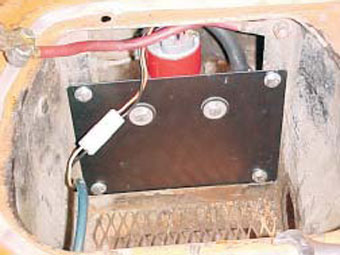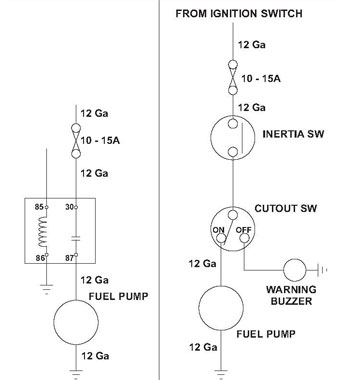

16 gauge steel fuel pump mounting bracket with rubber insulating washers (both sides) for noise reduction.
Fuel Pump Installation
This article appeared in The British V8 Newsletter - Volume X, Issue 1 - January 2002by: Dan Masters
Depending on the power level of your new engine, you may be able to get by with the
stock fuel pump. Chances are, you will want to move up to a higher capacity pump -
what good are all those horses if you can't keep them fed?
The fuel pump on my bone stock MGB GT failed last month, so I decided to replace it
with the Holley I had on hand, which I had been saving to use when I finally got
around to doing the V8 swap. I could have installed the new pump in the same location,
using the same mounting details, as the factory installation, but I really didn't
like that option. After a little head scratching, I came up with the scheme shown
in the photos below.
When I finally get around to doing the engine swap, I will also redo the fuel tank
location (to allow dual exhaust), and reroute the fuel lines. For now, though, this
installation required no modifications at all to the fuel lines - just slipped new
fuel lines over the old hard lines, routed them to the new pump, and clamped the
lines in place using standard hose clamps. I'm not saying this is the best way to
install a pump, but it works for me.
If you use a larger pump, I think this method will have definite advantages over
most other locations. There is plenty of room for a large pump and all the fittings
required to feed larger diameter fuel lines.
If you have the rear suspension out of the car, and have the car up on jack-stands,
installing the pump is about as easy as it gets. If you're installing it the way I
did, with everything in place (except the rear wheel, which I did remove), here are
a couple of tips you might find useful:
1) Make the holes in the battery box first, then hold the mounting plate up to the
box and scribe locating marks for the matching holes in the plate. It is hard to get
to the battery box brackets, so it is very easy to wind up with the holes slightly
off from where you intended. The mounting plate can be drilled on your workbench,
with a much higher degree of accuracy. By making the bracket holes first, you can
ensure a perfect match.
2) If you can, use a hole punch, rather than a drill to make the holes in the battery
box. There isn't a lot of room for an electric drill. I have a Roper-Whitney hand
punch that works very well for this. In fact, this punch works so well that I use it
to punch holes in sheet metal even when I do have perfect access for a drill. The punch
makes a clean, round hole with no burrs.
|
Enjoying this article? Our magazine is funded through the generous support of readers like you! To contribute to our operating budget, please click here and follow the instructions. (Suggested contribution is twenty bucks per year. Feel free to give more!) |
3) Carefully check the location of the pump and the routing of the new fuel lines,
to ensure there is no interference with the rear suspension. You certainly don't
want to wear a hole in a fuel line, or crack the pump housing.
There are a few options for wiring the pump: The first option is to just wire the
pump to the existing wires. I used a two-pin connector, but that isn't necessary.
Simple splices will do, but it will be harder to remove the pump for repairs if needed.
A second option is to use a relay, wired as described in the May issue article on a
custom wiring system. A revised schematic for this is shown below, modified to work
without the relay panel as described in that article. See the May issue for a
description of the circuit operation.


Two other options are shown in the diagrams above. The diagram in the center uses a
relay, but has no provision for manual switching. Any time the ignition switch is
on, the fuel pump is also on. Missing from this circuit is the inertia switch. I
strongly recommend using an inertia switch because without one the fuel pump might
continue to operate following an accident, and could pump a lot of gas onto the
ground if a fuel line ruptures.
The circuit on the right describes the use of an "ON - OFF" control switch, along
with an inertia switch, but no relay. When the switch is in the "ON" position, the
pump turns on and off with the ignition key. When the switch is in the "OFF"
position, the pump will not operate, but the warning buzzer will sound to remind
you that the switch is off. This switch provides a bit of theft protection. If you
use this switch, it should be mounted out of sight, but within easy reach of the
driver. The buzzer serves to remind you to reset the switch before driving off
and running out of fuel. If the switch is off, the buzzer will sound as soon as
you turn on the ignition (don't ask me how many times I've heard the buzzer in my
car - I'm more than just a bit forgetful).
Except as shown, the wiring should be 14 gauge. You could probably get by with using 14 gauge wire for all of the wiring, but you should use a pump that draws no more than a 10 amps if you use the smaller wire. The inertia switch should also be mounted where it's easy to reach by the driver, as you want to be able to reset it without stopping, should it operated from the shock of hitting a pothole in the road. In general, these inertia switched are not prone to mis-operation, but why take a chance. If you use the wiring scheme presented on the previous page, the warning will sound if the inertia switch should operate. If the switch is in easy reach, you can simply reset it on the run, and not miss a lick.
Disclaimer: This page was researched and written by Dan Masters. Views expressed are those of the author, and are provided without warrantee or guarantee. Apply at your own risk.

